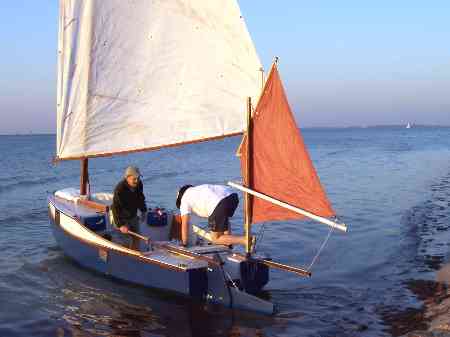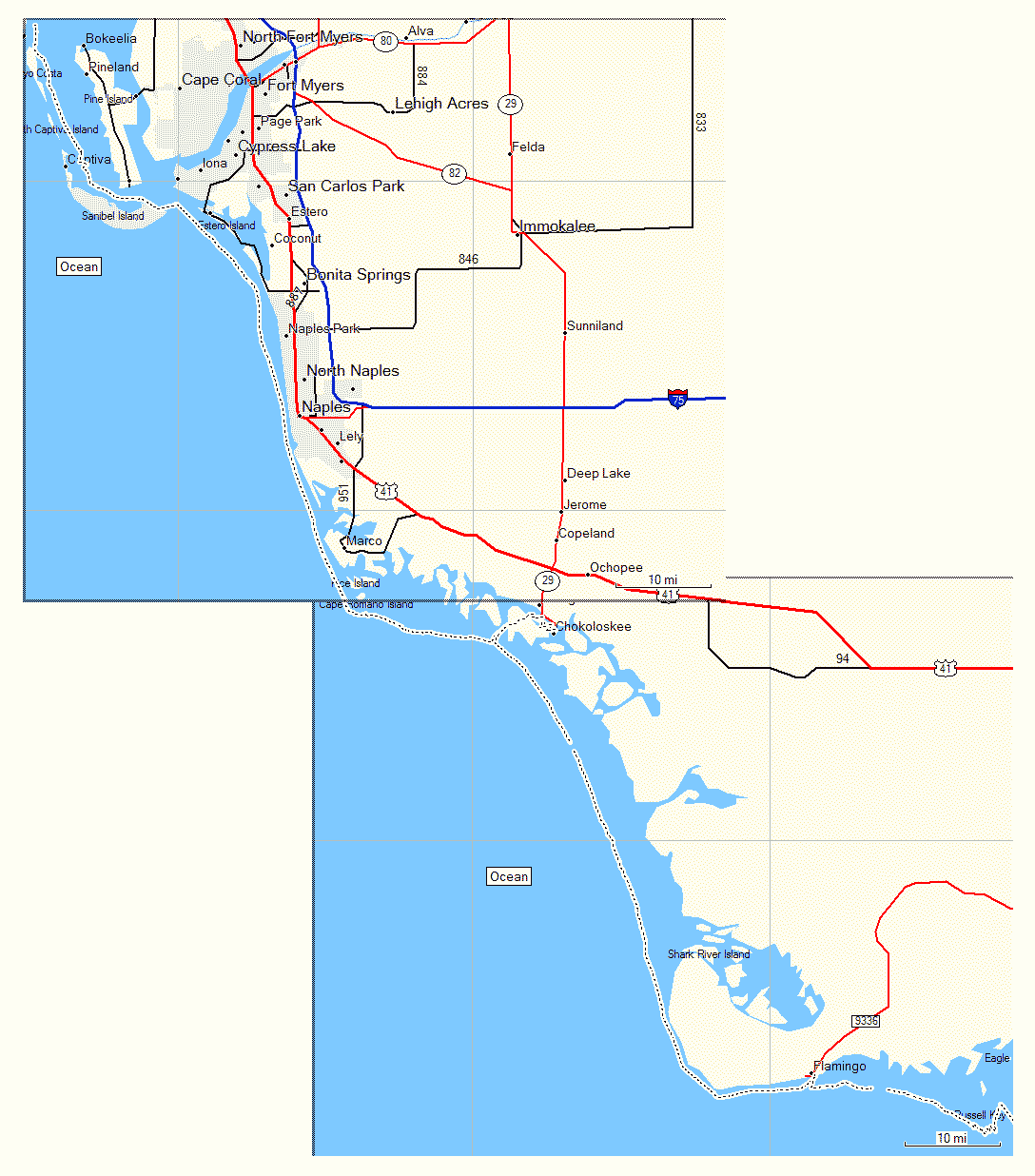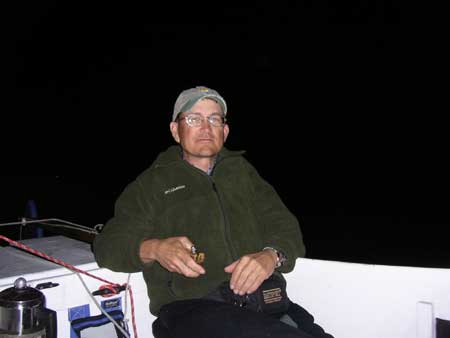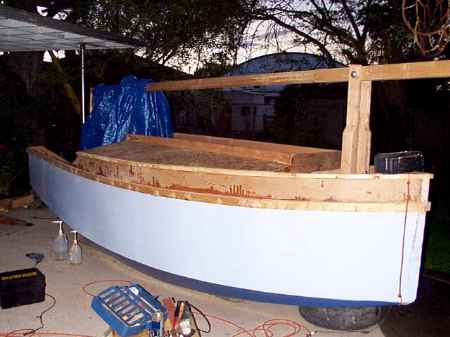
Gary Blankenship's Frolic2 at Key Largo journey's end.
Contents:
Contact info:
Jim Michalak
118 E Randall,
Lebanon, IL 62254Send $1 for info on 20 boats.
Jim Michalak's Boat Designs
118 E Randall, Lebanon, IL 62254
A page of boat designs and essays.
(1apr06) This issue will take us along the Everglades Challange 2006 with Gary and Chuck. The 15apr06 issue will review taped seams.
THE BOOK IS OUT!
BOATBUILDING FOR BEGINNERS (AND BEYOND)
is out now, written by me and edited by Garth Battista of Breakaway Books. You might find it at your bookstore. If not check it out at the....ON LINE CATALOG OF MY PLANS...
...which can now be found at Duckworks Magazine. You order with a shopping cart set up and pay with credit cards or by Paypal. Then Duckworks sends me an email about the order and then I send the plans right from me to you.
MESSABOUT NOTICE:
THE REND LAKE MESSABOUT WILL TAKE PLACE ON JUNE 9, 10 AND 11 AT THE GUN CREEK RECREATION AREA AT REND LAKE IN SOUTHERN ILLINOIS. MORE DETAILS WILL FOLLOW BUT IT MIGHT BE PRUDENT TO MAKE CAMPING RESERVATIONS AT THE GUN CREEK (CORPS OF ENGINEERS) CAMPGROUND IF YOU INTEND TO ATTEND.

|
Left:
Gary Blankenship's Frolic2 at Key Largo journey's end.
|
|
|
EC 2006
THREE CHEERS FOR GARY AND CHUCK!... HURRAH!... HURRAH!... HURRAH!....
...who, at an age when they should have known better, took on the Everglades Challange 2006, a "race" from Tampa to Key Largo. Gary is Gary Blankenship and Chuck is Chuck Leinweber of duckworksmagazine.com. The boat used by them was Gary's Frolic2 which he calls "Oaracle" (not to be confused I hope with my rowboat design "Oracle"). Gary had tried the event a couple of years ago when the boat was brand new and did not make the first check point in time as he was trying to race and sort out a new boat at the same time.
First a note about the race. Here is a map of the event

Chuck added this in a letter:
"The Watertribe folks - actually one guy, Steve Isaacs AKA "Chief" - run three races simultaneously: 1) the ultimate marathon - an 80 mile sprint down the coast; 2) the everglades challenge - the 300 mile race that we participated in and the most popular of the bunch; and 3) the ultimate Florida challenge - the 1200 mile circumnavigation of the state. It goes on beyond our destination of Key Largo, back up the Atlantic side, up the St Mary's River (northern border of the state), portages 40 miles (human power), puts into the Suwannee River, goes back to the gulf and from there back to Tampa bay. We did not feel we could make that portage with the Frolic. Also the $1500 entry fee was a little daunting. Our race was only $295 each - a relative bargain."

Boats must be launched by their crews off the beach so nothing really large is going to be in the event. Photo shown above is of the Frolic prepared for launch with rollers beneath. (Photos by Chuck, Gary, Bill Paxton, and Helen Snell.)
Then a launch at dawn, here with Chuck at the tiller and Gary pushing. (Note that the little mizzen is Gary's custom addition. Otherwise the Frolic2 looks totally to the plans right down to the offset rudder.)

And then off into the watery wilderness. Looks like the weather was quite calm and perfect for a beach launch.

But I take it the wind piped up. Gary wrote,"Mostly I wanted to let you know how well Oaracle handled the weather. There were small craft advisories for the first, part of the second, the fourth and fifth days we were out. Boat didn?t seem to care. Chuck?s GPS recorded a burst to 12.4 mph (about 10.8 knots) the first day in 15-20 NNW winds and 4-5 foot seas that we frequently surfed down. We sailed something like 60 miles in 11 hours before cutting in to the Intracoastal. "
Here is a photo of Gary at the tiller off Sarasota with a reef in:

Chuck has a fancy gps and he sent me a track copy that picks up the story at Cape Coral:

Here is a photo of Chuck he called "midnight off Naples":

Looks like a downhill sail until they diverted to Chokoloskee which was a mandatory check point. Chuck added,"We sailed down Pine Island sound (the protected water in the upper left) and out the pass just before sundown. We had a nice 10 mph northerly so we proceeded down past Naples during the night. We hit Cape Romano at dawn and lost our wind, so we rowed off and on until the breeze came back and we made Chokoloskee just after noon. We showered and had a restaurant meal that evening and left the next morning early. There was a northerly again at 15-20 and we romped down the coast to Cape Sable rounding it at dusk and navigating by GPS and lights to Flamingo that night."
Leaving Chokoloskee I think they met the first serious headwinds as they had to sail west until they could turn south again. Here is the gps track leaving Chokoloskee:

The tacks look very good to me considering the low tech rig and the shallow water. Gary added:"Chuck also sent me a track of our route in and out of Chokoloskee, near Everglades City (checkpoint 2) The last couple tacks there, where we had better protection and less chop and were able to get the board fully down. look like almost perfent 90 degree angles. We also had one reef in the sail. I'll attach that track . . . (The flat angle at one tack is where we ran on an oyster bar and had to raise the board & rudder and reach off . . .) Interesting style note: Chuck likes to sail to windward with the sail in front of the mast fluttering, while I like a good fill and no flutter. Looking at the tracks, I don't think there was much differents in final speed or progress between one way or the other." He added the photo of Gary paddling in the tougher areas near Chokoloskee and you can see the area is not really sailboat friendly:

Then they turned south again for another downhill run. Gary wrote,"The next day was one for the books. We started with one reef, but after a few hours put in the second, with no reduction in speed. We were broad reaching in 15-25 mph of wind, with steep four foot seas, and were basically above Oaracle?s theoretical hull speed until we rounded SW Florida. The straight line distance from the Everglades City pass to where we turned around the SW tip of Florida is 46 nautical miles, and we covered the distance on 8.5 hours. But that doesn?t tell the whole story. The straight line goes right through Northwest Cape at Cape Sable, who we added a couple miles distance there, plus we were stopped for several minutes to tie in the second reef. The winds also moderated slightly the last 90 minutes or so; at least my GPS stopped going over 7 knots and occasionally 8 so much. . . The motion was lively, but we never felt out of control, especially after the second reef. We did nearly get broached by a breaking wave; Chuck was in the middle of the boat at the time sponging the spray back into the Gulf of Mexico, and that may have contributed."
They turned eastward past Cape Sable which on my map looks to be the end of the Florida mainland and headed to Flamingo for another mandatory check point. They got another hot meal and a bit of sleep and then back to the water in the very early morning as this departure photo shows:

(Chuck corrected me saying,"Flamingo was deserted – it had been heavily damaged by hurricanes last year and construction was everywhere. No restaurants were open and besides, we arrived after dark and left at dawn – the point is: no hot meal.")
Then they had to hammer their way through Florida Bay. Very shallow water here, lots of islands and a headwind through it all. Gary wrote,"Oaracle also did well the last day in the shallow bays & cuts of Florida Bay. When we hit the sides of the cuts, we could always get it off without going wading, except in the next to the last cut where the wind kept us on the bank (we had to get out and tow in the knee-deep muck). We sailed part of the day with a Sea Pearl and they had a lot more trouble getting off, and eventually feel behind and took another route."

"Most of the first 60 percent or so of the day was sailed with the leeboard at least partly up. Even in the "deep" cuts sometimes the water was 2 feet or less. Chuck was very good about getting the best out of Oaracle with lee helm from a partially raised board. (We should have had the small 13 square foot mizzen up to help with the lee helm, but it didn?t occur to us. We had taken it down the day before to ease the weather helm on the wild run down the Everglades coast.) The last not quite five hours were spent beating dead to windward to the finish (a straight line distance of about 10 nautical miles), but at least the board was fully down. It was our only windward work, other than three miles beating up Chokoloskee Bay (which took two hours) leaving Everglades City. In a good breeze, Oaracle makes good two knots or maybe a little better, and I have no idea whether that?s good or bad. Chuck sent me a track from his GPS on this windward work, and it looks very good to me. Allowing for leeway and being pushed by the chop, we must have been doing nearly 90-degree tacks."
And here is a copy of the track through the Bay:

And then to finish at Key Largo just at sunset:

WELL DONE! Chuck told me it was all pretty easy and might take Sandra next year. But I must remind everyone that if that long sail down the west coast must be done with a wind from the south, it will be a very long trip indeed.
NEXT TIME...
...I will rerun the important article about joining plywood sheets.
FROLIC2

FROLIC2, CUDDY MULTI SKIFF, 20' X 5', 400 POUNDS EMPTY
The photos show the prototype Frolic2 built by Larry Martin of Coos Bay, Oregon. Larry built the boat quite quickly this past winter including sewing the sail to the instructions given in the plans. He reported sailing it for the first time on a ripping day with an occasional 2' wave. I always advise testing a new boat in mild weather, especially a new design, but Larry got away with it. Looking at his photos, the neat work, and simple efficient rigging suggests to me that Larry has been sailing small boats a long time.

Frolic2 has a small cabin, probably only for one to sleep in because the multichines that make the boat good in rough water also rob you of floor space. To say it another way, the nice big floor space of a flat bottomed sharpie is what pounds in rough water and makes you uncomfortable. But Frolic2 has a 6' long cockpit so someone could sleep there too. There is bench seating. The cabin top has a slot top down the center and you can stroll right through the cabin standing upright in good weather and out the front bulkhead to the beach. The mast is offset to one side so you will need not have to step around it. Phil Bolger showed us how to do this about 15 years ago and it works. But Larry went conventional with his boat, mounting the mast on centerline and decking in the front of the cabin. On a slot top cabin you use a simple snap on tarp to cover the slot in rain or cold or bugs.

Frolic2 was designed for rough water, long and lean, especially in the bow, and with multiple chines. She's really a takeoff of my Toto canoe in shape. Larry omitted the motor well you see in the lines, and the oarlocks too (The wind must blow just right all the time in Oregon?) but I intended this to be a multi skiff sort of boat with rowing and motoring abilities. You can't row a boat of this size in any wind or waves but in a calm you can travel far if you have patience. I didn't fool around with a gadget motor mount - I put the motor well right in the middle and offset the rudder instead of the other way around. This worked out very well on the high powered Petesboat. We'll see how it goes on a narrow boat because the second prototype is getting the blueprint well as you see in the photo below of the Colorado Frolic2 still being built. You need little power on a boat like this, 2 or 3 hp is more than enough.
The lug rig is for quick easy stowing, rowing, and towing. (The blueprint sail is actually the same size and shape as that of a Bolger Windsprint, a boat which weighs maybe a third as much as Frolic2 and is much narrower. But I think the Windsprint might be over sparred for its size and weight.) Larry reports the rig is about right for the boat, sailing fine with a reef in and three adults on a windy day. The lug sail can be closer winded reefed than when full, perhaps because the sail is then shorter and the yard better controlled (less sail twist). For that matter a sharpie sprit sail the same size as the lug might be smarter in rough water conditions if you can live with the long mast. Switching rigs won't be hard. The mast can be relocated almost anywhere in the slot top without altering the hull to any degree. You just need extra partner and step fittings.


Update, 2006. Jeff Blunk's Colorado Frolic2 eventually found its way to Illinois and then to our Rend Lake Messabout in the hands of Richard Harris. We had a chance to try it out and I was quite pleased. It was fast and powerful. At one point with three men on board, with Max at the tiller, I went forward to tweak the sail which took a couple of minutes with me staring up at the sail. That done I looked back and saw that we were really rolling along.

And Gary Blankenship's Frolic2 completed the Everglades 300 mile challange with him reporting sailing for hours at 7 knots or more. Here is Gary's Frolic2:

Construction is with taped seams from eleven sheets of 1/4" plywood and two sheets of 1/2" plywood.
Plans for Frolic2 are $35.
Prototype News
Some of you may know that in addition to the one buck catalog which now contains 20 "done" boats, I offer another catalog of 20 unbuilt prototypes. The buck catalog has on its last page a list and brief description of the boats currently in the Catalog of Prototypes. That catalog also contains some articles that I wrote for Messing About In Boats and Boatbuilder magazines. The Catalog of Prototypes costs $3. The both together amount to 50 pages for $4, an offer you may have seen in Woodenboat ads. Payment must be in US funds. The banks here won't accept anything else. (I've got a little stash of foreign currency that I can admire but not spend.) I'm way too small for credit cards.
The out West Picara is I am told done to the point of using it as a powerboat:

The down South Picara is more or less complete now. Should have an updated photo soon.

This long and lean project is a 19' version of Toon2. Shown here on its first sail in very light winds. We will wait a bit longer to get a sailing report in stronger winds.

A Vector builder is keeping a website of the project at http://www.geocities.com/michsand@sbcglobal.net/ and here is a photo of his boat on its first sail, just before the storm hit. I also have photos of a Vector completed by Pete Mohylsky in Florida. Hopefully a report soon:

Here is a Musicbox2 I heard about through the grapevine.

We have a Philsboat going together in California:

And here is another Philsboat in northern Illinois:

AN INDEX OF PAST ISSUES
Hullforms Download (archived copy)
Plyboats Demo Download (archived copy)
Brokeboats (archived copy)
Brian builds Roar2 (archived copy)
Herb builds AF3 (archived copy)
Herb builds RB42 (archived copy)